Samacheer Kalvi 3rd Standard Science Book Solutions Term 3 Chapter 2 Animal Life
I. Choose and write the correct answer.
Question 1.
Mosquito sucks its food. Which of the animals given below such their food?
a) Cockroach
b) Parrot
c) Butterfly
Answer:
(c) Butterfly
![]()
Question 2.
Bear sometimes eats pumpkin and sometimes eats fish. So, it is an _________.
a) Carnivore
b) Omnivore
c) Herbivore
Answer:
(b) Omnivore
Question 3.
A bird that has beak which helps it to crack open shells and eat the seed inside is __________.
a) Sparrow
b) Owl
c) Kingfisher
Answer:
(a) Sparrow
Question 4.
Flesh eating animals have well developed ______.
a) Molars
b) Tusks
c) Canines
Answer:
(c) Canines
Question 5.
Elephant is a _______.
a) Herbivore
b) Carnivore
c) Omnivore
Answer:
(a) Herbivore
![]()
Question 6.
Choose the carnivore.
a) Deer
b) Lion
c) Giraffe
Answer:
(b) Lion
Question 7.
In a food chain, a ______ can be placed immediately before a snake.
a) Eagle
b) Frog
c) Grass
Answer:
(b) Frog
Question 8.
Select the animal that has similar eating habit like a bear.
a) Camel
b) Deer
c) Hen
Answer:
(c) Hen
Question 9.
Find the odd one based on the habitat.
a) Deer
b) Fish
c) Fox
Answer:
(b) Fish
Question 10.
Which of the following has different eating habits compared to the others?
a) Elephant
b) Cow
c) Dog
Answer:
(c) Dog
![]()
II. Fill in the blanks.
Question 1.
A small habitat is ________(forest / leaf).
Answer:
leaf
Question 2.
Butterflies suck ________ (nectar / water) from flowers.
Answer:
nectar
Question 3.
Chisel beak is present in ________ (sparrow / woodpecker)
Answer:
woodpecker
Question 4.
The parrot eats ________ (rats / nuts).
Answer:
nuts.
Question 5.
A food chain always beains with ________. (plants / animals).
Answer:
plants
III. Answer the following questions.
Question 1.
Land and water are common habitats. What is a habitat?
Answer:
The living place of an animal or a plant is called habitat.
Eg: Whales live in sea (water) and foxes live in forest (land).
Question 2.
Give two examples for each.
a. Terrestrial Animal : ________, ________
b. Aquatic Animal : ________, ________
Answer:
a. Cats, Lion
b. Fish, Crab
Question 3.
Why animals move from place to place?
Answer:
Animals move in search of food.
![]()
Question 4.
Nectar is the food of bgtterfly. Then, what is the food of earthworm?
Answer:
Soil with organic wastes Differentiate a herbivore from a carnivore.
Question 5.
Differentiate a herbivore from a carnivore.
Answer:
| Carnivore | Herbivore |
| 1. Flesh eating animals are called carnivorous or carnivores Eg Hena, Tiger, Lion, Cheetah and seal | 1. Animals that eat only plants are called herbivorous animals or herbivores
E.g., Deer, Giraffe, Cow, Goat and Elephant. |
| 2. Have sharp, pointed teeth called canines and used to tear the flesh of animals | 2. Have sharp, straight edged, flat front teeth called incisors to bite the grass and leaves. |
Question 6.
Is human an omnivore or carnivore?
Answer:
Omnivores.
Question 7.
Give an example of a food chain.
Answer:
grass → deer → tiger.
![]()
Question 8.
Choose the correct food chain from the following.


Answer:
c. Leaves → Insect → Bird
In-Text Activity:
Warm-up (Text Book Page No. 71):
Identify and write the names of the animals by using the keywords given.
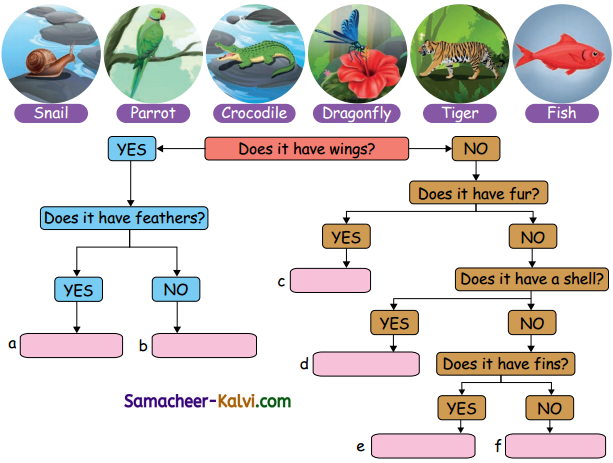
Answer:
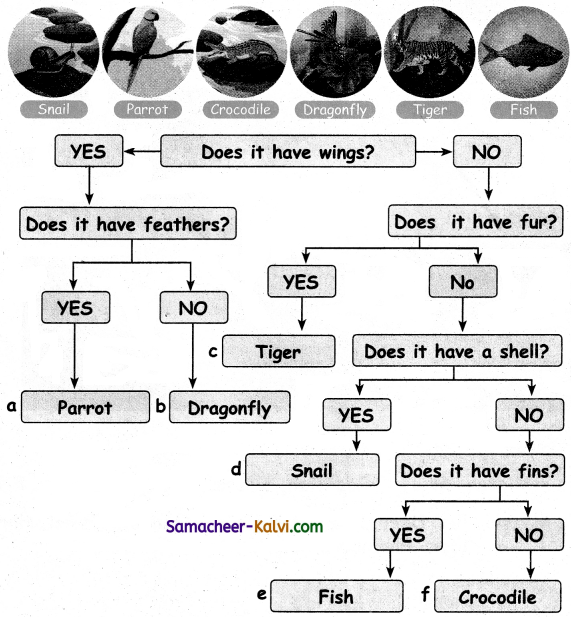
![]()
Let us Connect (Text Book Page No. 74):
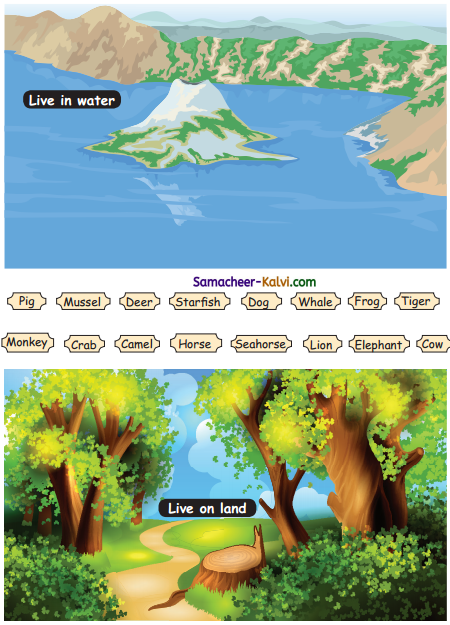

Answer:
Live in Water:
Mussel, Starfish, Whale, Crab, Seahorse, Frog.
Live in Land :
Pig, beer, bog, Frog. Tiger, Monkey, Camel, Horse, Lion, Elephant, Cow.
![]()
Let us help (Text Book Page No. 75):
There is a zoo near your town. bue to some reasons, they have to take the animals bock to their habitat. Where will they take each of the following animals.
(Tiger, Crab, Turkey, Giraffe, Cat, Fish, Bear, bonkey, Camel, Crow, Zebra, Duck, Elephant, Tortoise, Pig, Peacock, Lion)
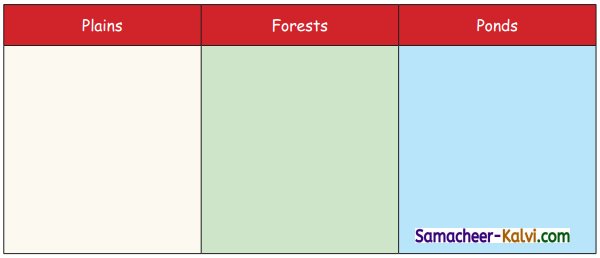
Answer:
| Plains | Forests | Ponds |
| Turkey | Tiger | Crab |
| Cat | Giraffe | Fish |
| Donkey | Bear | Duck |
| Camel | Zebra | Tortoise |
| Crow | Elephant | |
| Pig | Peacock | |
| Lion |
Let us Find (Text Book Page No. 75):
A) Circle the odd one based on habitat.
Question a.
a) Lion
b) Elephant
c) Monkey
d) Whale
Answer:
d) Whale
Question b.
a) Shark
b) Dog
c) Jellyfish
d) Star fish
Answer:
b) Dog
B) Write the names of the animal with the help of the clues given.
(Penguin, Whale, Octopus, Duck)
![]()
Question 1.

________ has eight arms. It lives in the ocean.
Answer:
Octopus
Question 2.

________ cannot fly, but it swims very well
Answer:
Penguin
Question 3.
________ is the largest animal in the sea.
Answer:
Whale
Question 4.
________ is a common water bird.
Answer:
Duck
Let us connect (Text Book Page No. 77):
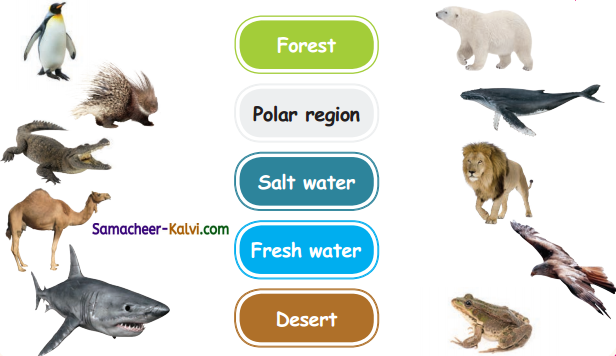
Answer:
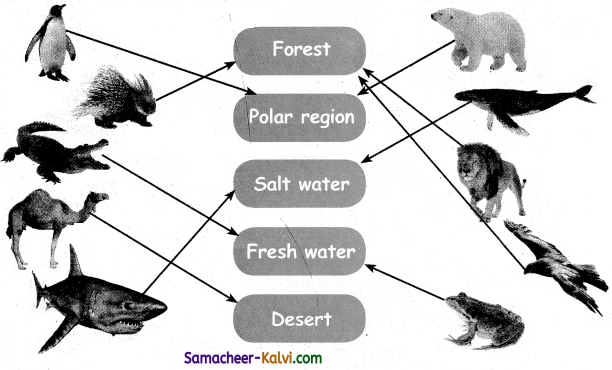
![]()
Let us connect (Text Book Page No. 78):
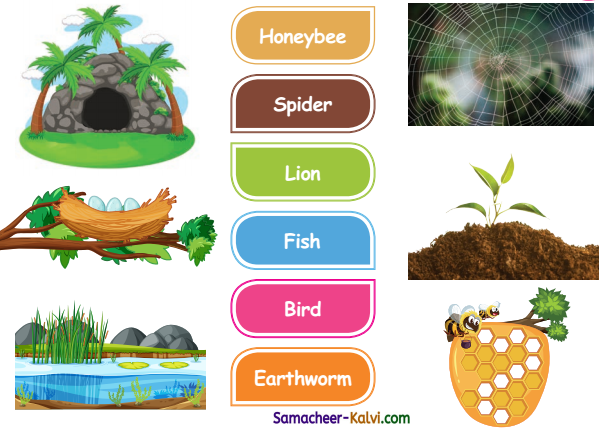
Answer:
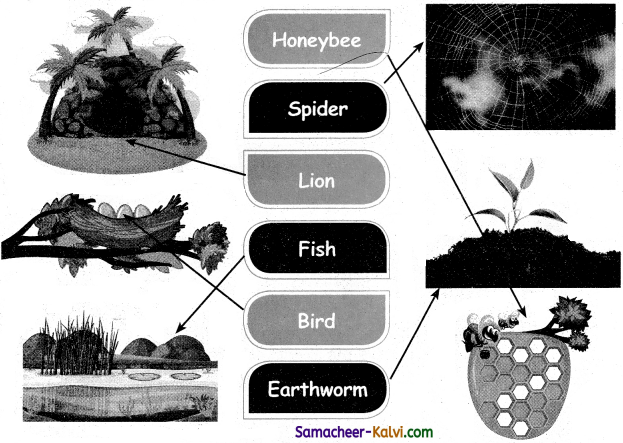
II. How do animals get their foods?
Write the foods of given animals using the following words.
(Carrot, deer, Milk, Grass, Grains)
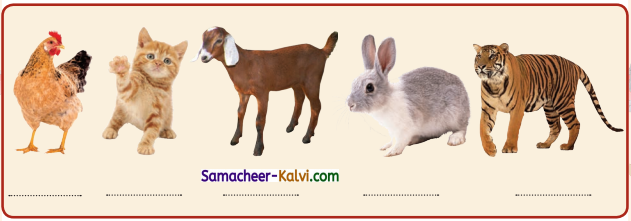
Answer:

![]()
Let us discuss the following and complete the sentence (Text Book Page No. 79):
(earthworm, butterfly, mosquito, spider, elephant. lion, hen)
Question 1.
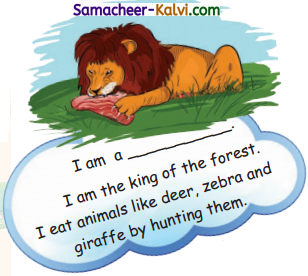
Answer:
Lion
Question 2.
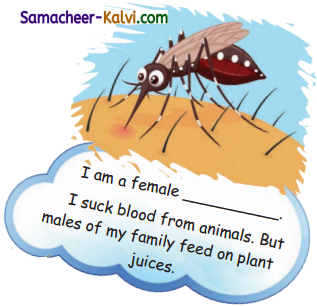
Answer:
Mosquito
Question 3.

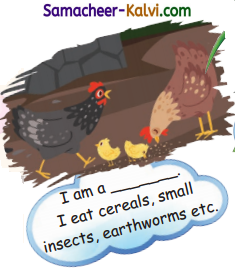

Answer:
Hen
![]()
Question 4.
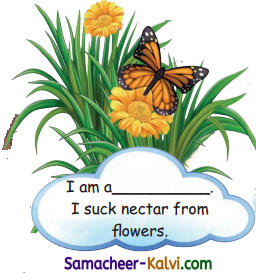
Answer:
Butterfly
Question 5.
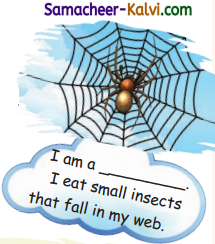
Answer:
Spider
Question 6.
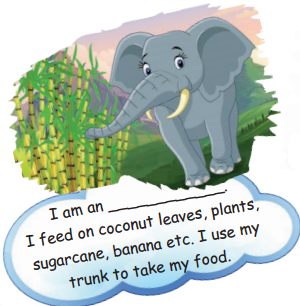
Answer:
Elephant
![]()
Question 7.
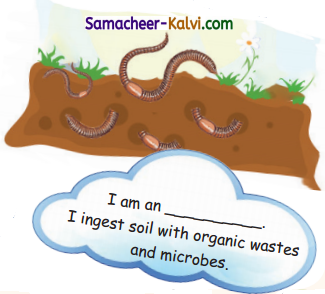
Answer:
Earthworm
Let us connect (Text Book Page No. 80):
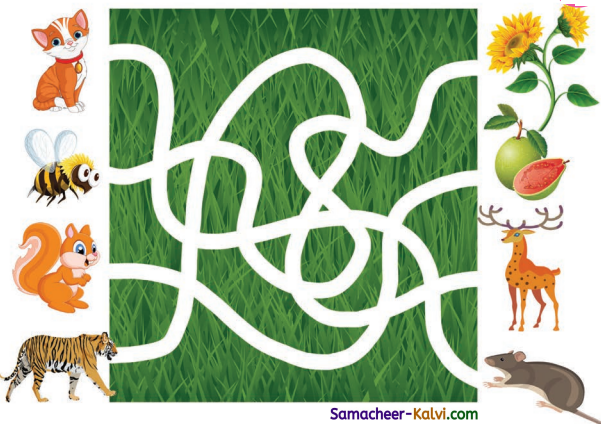
Answer:
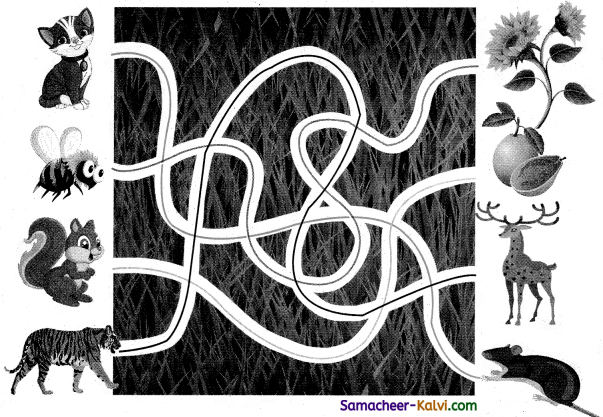
![]()
Let us do (Text Book Page No. 80):
Complete the worksheet using the following hints.
(Tiger, Lizard, beer, Dove, Honeybee, Butterfly, Goat, Fax, Squirrel, Woodpecker)
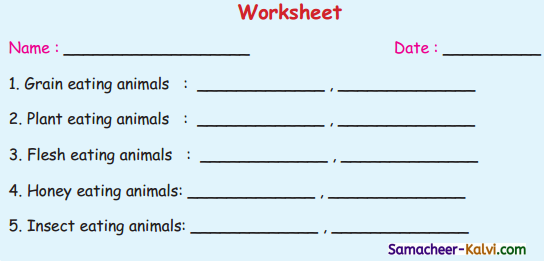
Answer:
- Grain eating animals: Dove, squirrel
- Plant eating animals: Deer, Goat
- Flesh-eating animals: Tiger, Fox
- Honey eating animals: Honey Bee, Butterfly
- Insect-eating animals: Lizard, Woodpecker
Let us think (Text Book Page No. 81):
Question 1.
Elephant is a herbivore. But ¡ts front teeth are not flat. How can we call them?
Answer:
Tusks
Think and Answer (Text Book Page No. 82):
You tell your friend that you are an omnivore. But he tells that he ¡s an herbivore. It is right or wrong? How?
Answer:
Right, but humans are considered to be omnivore because of the capability to digest both plant animal matter. But some of them are said to be herbivores due to their vegetarian food habits.
Let us Connect (Text Book Page No. 83):
Observe the pictures and draw a line to connect them to the appropriate jars.
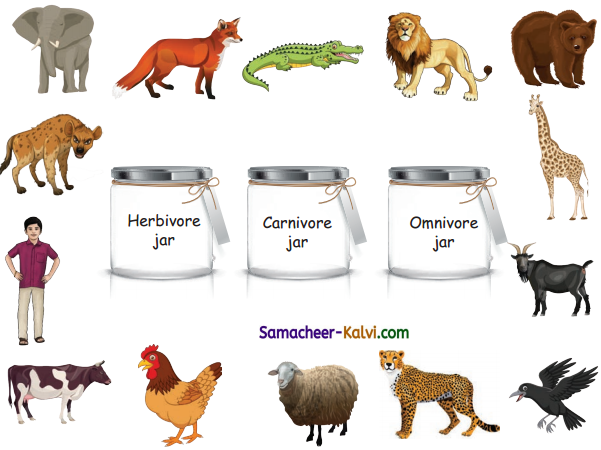
Answer:
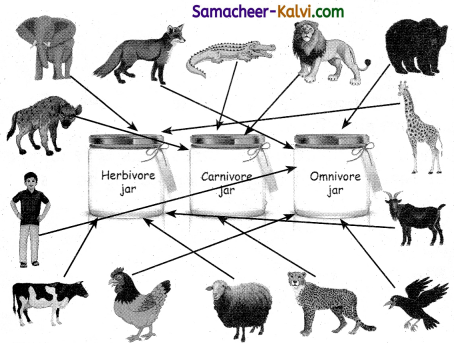
![]()
Let us find (Text Book Page No. 84):
Circle the foods that the animal will eat. You can choose more than one, if applicable.
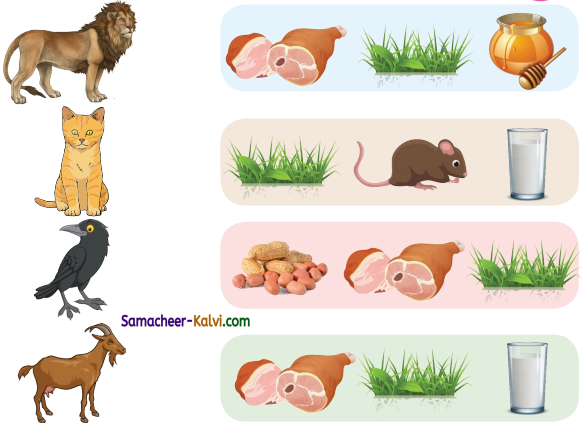
Answer:
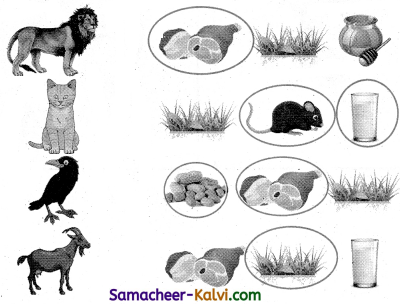
![]()
Let us find (Text Book Page No. 84):
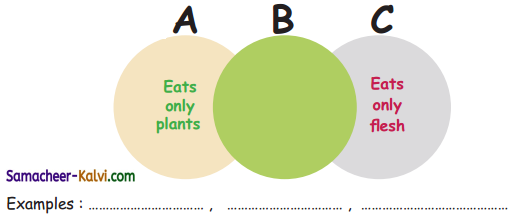
Answer:
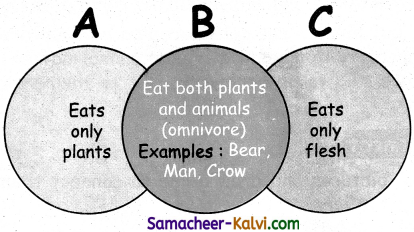
Think and Answer (Text Book Page No. 86):
Have you ever wondered why birds have beaks of different shapes and sizes?
Answer:
The most important function of a birds beak ¡s feeding and it is shaped differently according to their eating habits.
Let us draw (Text Book Page No. 87):
Question 1.
Draw the beaks of birds that perform the following functions.
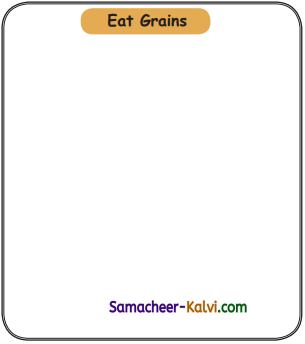
Answer:
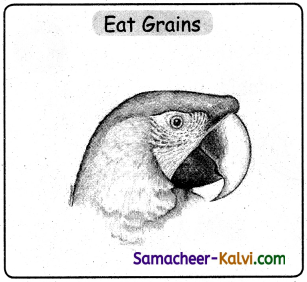
![]()
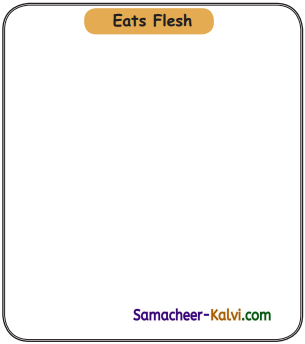
Answer:
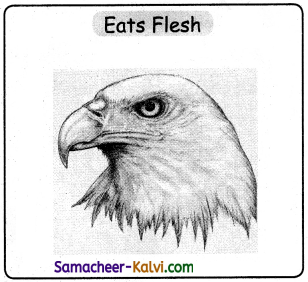
Let us find (Text Book Page No. 88):
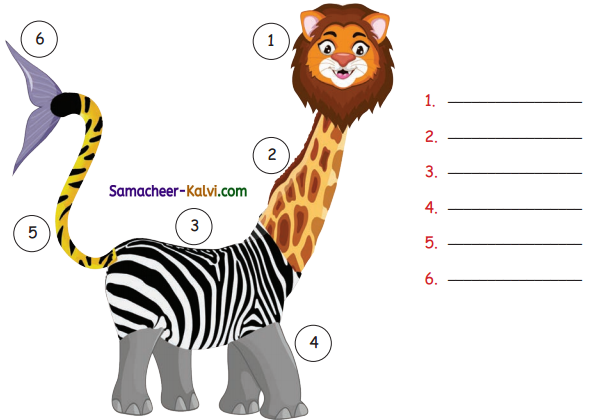
Answer:
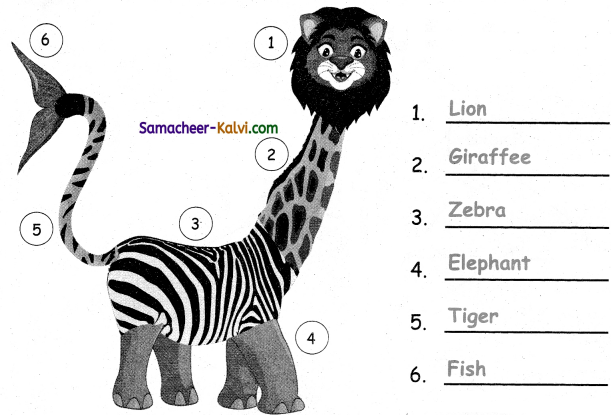
![]()
Try to Answer (Text Book Page No. 89):
Question 1.
Select the food chain that can exist in nature.
A. Grass → Wheat → Grasshopper → Frog → Snake
B. Grass → Rabbit → Fox → Lion
C. Wheat → Grasshopper → Snake → Frog
Answer:
B. Grass → Rabbit → Fox → Lion
Question 2.
From any two food chains using the following.
(Grass, Tiger, Deer, Dolphin, Fish, Insect, Snail, Plant, Kingfisher)
Answer:
Food Chain 1:
Grass → Deer → Tiger
Food Chain 2:
Insect → Fish → Kingfisher
Let us complete (Text Book Page No. 90):
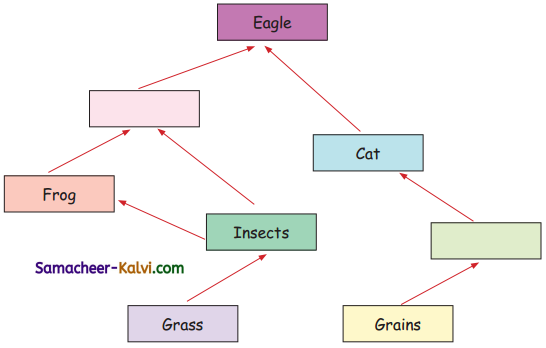
Answer:
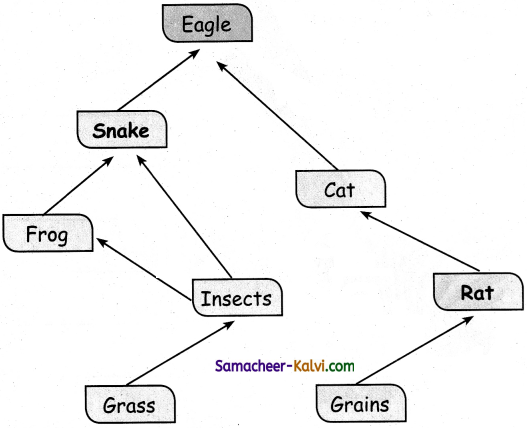
![]()
3rd Standard Science Guide Animal Life Additional Questions and Answers
I. Choose the correct answer.
Question 1.
Sharp pointed teeth are called _______.
(a) molars
(b) premolars
(c) canines
Answer:
(c) canines
Question 2.
Animals that have a combination of tearing, biting and grinding teeth are called _______.
(a) Omnivores
(b) Carnivores
(c) Herbivores
Answer:
(a) Omnivores
Question 3.
Animals that hunt other animals are called _______.
(a) producers
(b) predators
(c) decomposers
Answer:
(b) predators
Question 4.
Animals that fly most of the time are called ______ animals.
(a) aerial
(b) arboreal
(c) amphibians
Answer:
(a) aerial
Question 5.
_______ are the habitat of animals like rat, cow, camel.
(a) Plains
(b) Forest
(c) Water
Answer:
(a) Plains
![]()
II. Fill in the blanks.
Question 1.
_______ are the habitat of animals like bear and bison. (Plain / Forest)
Answer:
Forest
Question 2.
Animals that live on land are called as ______ animals (terrestrial / aquatic).
Answer:
terrestrial
Question 3.
Pond, lake, and river are habitats, (fresh water / sea water)
Answer:
fresh water
Question 4.
An example for salt water habitat is _______.(sea / river)
Answer:
sea
Question 5.
Animal that lives on trees are called _______. (arboreal/aerial)
Answer:
aerial
Question 6.
A natural home for wild life is _______. (forest / plains)
Answer:
forest
III. True or False.
Question 1.
Shark lives in salt water.
Answer:
True
Question 2.
Lion lives in a nest.
Answer:
False
Question 3.
A hen eats cereals, insects and earthworms.
Answer:
True
Question 4.
Giraffe is a plant eater.
Answer:
True
Question 5.
Animals that are hunted are called prey.
Answer:
True
![]()
IV. Match the following:
| 1. Forest | a. Builds web |
| 2. Desert | b. Suck nectar |
| 3. Spider | c. Suck blood |
| 4. Mosquito | d. Lion |
| 5. Butterfly | e. Camel |
Answer:
| 1. Forest | a. Lion |
| 2. Desert | b. Camel |
| 3. Spider | c. Builds web |
| 4. Mosquito | d. Suck blood |
| 5. Butterfly | e. Suck nectar |
V. Answer the following questions.
Question 1.
What are Amphibians?
Answer:
Animals that need both land and water to live are called amphibians.
Question 2.
Give example for arboreal animals.
Answer:
Monkey, Squirrel.
Question 3.
What are aerial animals?
Answer:
Animals that can fly most of time are called aerial animals.
Question 4.
Name the two types of water habitat.
Answer:
- Fresh water
- Marine water
Question 5.
Name some animals that live on plains.
Answer:
Ants, cats & lion.
Question 6.
Name two salt water habitats.
Answer:
Sea and ocean
Question 7.
How do animals get their food?
Answer:
Animals cannot make their own food, they depend on plants or other plant-eating animals for their food.
Question 8.
Name 2 honey-eating animals.
Answer:
Honey bee & butterfly.
Question 9.
Do all animals eat the same type of food?
Answer:
No, different animals eat different types of food because they have different food habits.
![]()
VI. Answer in detail.
Question 1.
Name the mouthparts of the below animals and their functions.
(a) Elephant
(b) Dog
(c) Cat
(d) Butterfly
(e) Mosquito
(f) Lizard
(g) Frogs.
Answer:
(a) Elephant – Uses its trunk for picking up food and sucking water.
(b) Dog – Licks liquids with the help of its tongue.
(c) Cat – Licks liquids with the help of its tongue.
(d) Butterfly – Has a tube like structure to suck nectar from flowers.
(e) Mosquito – Has a needle like structure to suck blood.
(f) Lizards – Have a sticky tongue to catch insects
(g) Frogs – Have a sticky tongue to catch insects.
Question 2.
Name the different shapes of birds beak.
Answer:
- Eagle – Sharp, curved beak
- Kingfisher – Spear like beak
- Parrot – Sharp beak
- Woodpecker – Strong chisel beak
- Sparrow – Short, conical
- Duck – Flat beak.
Question 3.
Write a note on the food web.
Answer:
A food web is an interconnection of multiple food chains. Transfer of energy between organisms of different energy occurs through the food web.